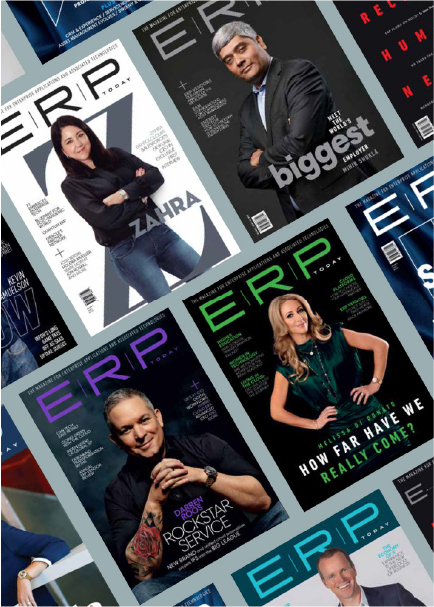Kyriba walked away with ERP Today’s 2024 Finance Solution of the Year award in December last year. At the time, the company was already making waves as a mid-market treasury system that challenged industry giants. Today, it is powering some of the world’s largest enterprises. Kyriba’s trajectory offers fascinating insights into what it takes to build truly resilient financial infrastructure in an increasingly complex business environment.
From Recognition to Revenue
“People buy on trust,” says Thomas Gavaghan, Kyriba’s SVP, Product Solutions & Strategy, reflecting on the award’s impact. “They don’t buy on features and functionality; they might say that, but at the end of the day, it comes down to trust.”
It’s a refreshingly honest take in an industry obsessed with feature warfare. However, the numbers back up this philosophy. Since winning the award, Kyriba has continued its remarkable ascent up the enterprise food chain, with household names such as McDonald’s, AIG, Prudential, MetLife, and Principal now operating on its platform. These are the companies “on the side of stadiums,” as Gavaghan colorfully puts it.
The transformation is striking. When Gavaghan joined Kyriba 11 years ago, the buying process was a relatively simple affair between treasury teams and the vendor. Today, every deal involves IT procurement, heavy RFP processes, and enterprise-grade scrutiny. The company has evolved from a $30,000 annual cash management tool to a comprehensive liquidity platform requiring complex ERP integrations and API-based architectures.
This evolution perfectly illustrates the broader shift toward financial resilience that’s driving enterprise technology decisions in 2025. Organizations are looking beyond point solutions towards integrated platforms that can handle the complexity of modern global finance while providing the transparency and control that modern risk management demands.
“People buy on trust.”
— Thomas Gavaghan, SVP Product Solutions & Strategy, Kyriba
The AI Reckoning
Perhaps Kyriba’s strategic maturity is most evident in its approach to artificial intelligence (AI). While competitors rushed to slap AI-powered labels on their marketing materials, Kyriba took a more measured approach, launching its Trusted AI (TAI) platform in April 2025 after years of careful development.
“We call it Trusted AI because there’s a little bit of a hype cycle going on with AI,” Gavaghan explains. “In verticals like ours, AI is very highly scrutinized. It’s not hand grenades and horseshoes here – it’s got to be spot on.”
The company’s co-innovation approach involved customers from day one, bringing together a diverse group of large and small enterprises from both Europe and the Americas, as well as global and regional companies, to help shape use cases and adoption strategies. This customer-centric development model addresses a critical challenge in AI adoption: the first-mover trust paradox, where organizations wait for others to validate the technology before committing to it.
However, Kyriba’s AI advantage extends beyond careful implementation. The company’s platform sits at the intersection of cash flows, debt levels, interest rates, FX data, market information, payment flows, and accounting records. This comprehensive data ecosystem provides Kyriba’s AI with unprecedented context, a significant moat in a market where AI is only as good as the data it works with.
The Platform Play
While newcomers continue to enter the treasury management space with lower barriers to entry and AI-enabled solutions, Kyriba’s differentiation strategy focuses on something much harder to replicate: ecosystem connectivity.
“The moat that we have is our integration and connectivity, an ecosystem that we’ve built and productized,” Gavaghan emphasizes. This isn’t just about having APIs; it’s about having battle-tested, enterprise-grade integrations that work reliably at scale.
The company’s Bank Connectivity as a Service offering exemplifies this approach. Through partnerships with major banks like Bank of America and Scotiabank, Kyriba now serves customers who would never have purchased its solution directly, such as family doctor offices that process payments through their bank relationships. It’s a brilliant expansion strategy that extends the reach of Kyriba’s platform while leveraging trusted banking relationships.
“In verticals like ours, AI is very highly scrutinized.”
The Strategic Finance Imperative
This ecosystem approach reflects a broader trend in enterprise technology—the shift from best-of-breed point solutions to integrated platforms that can handle complexity while reducing vendor sprawl. For CFOs and CIOs evaluating treasury solutions in 2025, this represents a fundamental strategic choice.
The old model of cobbling together separate systems for cash management, forecasting, risk management, and FX hedging is giving way to unified liquidity platforms that provide holistic visibility and control. This consolidation goes beyond operational efficiency to building the kind of integrated financial intelligence that enables truly resilient decision-making.
Kyriba’s journey from mid-market player to an enterprise platform illustrates this evolution perfectly. The company’s investments in ERP integration, API-first architecture, and comprehensive connectivity positioned it to capture the wave of digital transformation sweeping through enterprise finance.
Most intriguingly, Kyriba’s approach to AI reflects a mature understanding of technology’s role in enterprise resilience. Rather than positioning AI as a replacement for human expertise, Kyriba frames it as an augmentation of human expertise. According to Gavaghan, “AI doesn’t replace people. People who use AI will replace people who don’t.”
This philosophy extends to Kyriba’s implementation approach, where AI is treated like hiring a new employee, with training, context, guardrails, and specific responsibilities. It’s a refreshingly practical perspective that sidesteps the hype while focusing on real value creation.
The treasury management space is becoming increasingly crowded, with new entrants leveraging AI and lower development costs to target specific use cases. Some, like Statement.io, have already been acquired after brief runs in the market. This consolidation trend suggests that while barriers to entry may be lower, barriers to sustainable success remain high.
Kyriba’s response has been to double down on their platform strategy, recognizing that partial solutions, no matter how AI-enabled, can’t compete with comprehensive liquidity platforms backed by robust connectivity and proven enterprise deployments.
What This Means for ERP Insiders
Prioritize integration depth over feature breadth. The lesson from Kyriba’s success highlights a sustainable competitive advantage that stems more from connectivity and integration depth than from feature proliferation. Tech leaders should evaluate treasury and financial management solutions based on their ability to integrate seamlessly with existing ERP systems and provide unified data flows across the organization. Kyriba’s success with enterprise customers, such as McDonald’s and AIG, stems from its ability to handle complex, multi-system integrations that deliver real-time liquidity visibility across global operations. When evaluating financial platforms, prioritize vendors who have productized their integrations rather than offering custom toolkit approaches. This distinction often determines long-term implementation success and total cost of ownership.
Embrace co-innovation for AI adoption. Kyriba’s Trusted AI launch demonstrates the power of customer-driven AI development. Rather than rushing AI features to market, tech leaders should establish co-innovation programs with key customers to validate use cases and build confidence in AI applications. The company’s approach to bringing diverse customer groups into the development process, encompassing different geographies, company sizes, and industries, provides a blueprint for responsible AI adoption in financial services. This collaborative approach addresses the first mover trust challenge while ensuring AI implementations deliver measurable business value. For enterprise leaders, this means actively participating in vendor innovation programs and demanding transparency in AI model training and validation processes.
Build ecosystem platforms, not point solutions. The evolution of the treasury management market toward comprehensive liquidity platforms reflects a shift from best-of-breed point solutions to integrated ecosystems. Kyriba’s Bank Connectivity as a Service model, serving smaller businesses through banking partnerships, illustrates how platform thinking can expand addressable markets. Tech leaders should evaluate their financial technology stack through an ecosystem lens, considering how individual solutions contribute to overall financial resilience and decision-making capability. The future belongs to platforms that can unify cash management, forecasting, risk management, and FX hedging into coherent, AI-enhanced financial intelligence systems that support enterprise-wide strategic decision-making.






